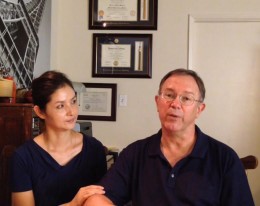$1.4 Million in Assets, a Million in Debt

I usually enjoy reading the money makeover column in the Los Angeles Times, which runs every two months or so (and, coincidentally, was once written by Helaine Olen in the ‘90s). The latest installment focuses on Ross and Michelle Meador, a couple who lives in Fullerton with their three children and have $1.4 million in assets including a house in Berkeley that they rent out, but a million dollars in debt, including student loans, a HELOC (home equity line of credit — basically borrowing against your house), and mortgage debt.
The problem: Ross Meador, at 59, is nearing the retirement age, but has just $345,000 in retirement savings; Michelle, 45, has just earned a dentistry degree and has no retirement savings. The couple doesn’t have an emergency fund and are worried about how they’re going to pay for their children’s college educations (the three kids are ages 12–17). Although Ross Meador is an attorney, his practice focused on helping small businesses, which were hit hard during the financial crisis, and he saw his income drop in half suddenly from $123,000 in 2008 to less than $52,000 in 2009. The recovery in income has been rough.
Not a hopeless case, right? Normally how this column works is the couple meets with a financial planner who lays out a plan of attack. And if, say, you also had a family and a good job and a house, but lots of debt, you could take some of the advice and apply it to your own life. But not this time around!
Because halfway through this column we learn that the Meadors have been fortunate enough to be the beneficiaries of a windfall:
In 2012, exploratory drilling on Texas scrubland that had been in the Meador family for years, mainly used for camping and hunting, tapped into natural gas, Ross said. The first royalty check arrived in December of that year.
“It’s been a godsend,” he said.
The Meadors’ monthly royalty check fluctuates but has been at least $4,700 and as high as $20,000. No one knows how long the natural gas will flow, but the family assumes it won’t last forever.
With careful planning, Somoano said, and by using the natural gas royalties judiciously, “the Meadors can have a cash surplus of about $500 a month.”
In Somoano’s conservative plan, the royalty income averages about $10,000 a month through the end of 2019, then falls to $5,000 a month before ending in 2024.
So, for the next five years, the Meadors will have an extra $10,000 a month — a conservative estimate! — to help them with their financial struggles? Suddenly this column has become dramatically unrelatable to the average reader. The advice from the financial planner that follows is based on the existence of this windfall. What are we supposed to make of this?
I suppose the takeaway is that windfalls happen sometimes. And also, the kids can go to community college and transfer to a university later to save money.
There’s still an answer to the Meadors’ financial dilemma if you take the windfall out of the equation. Ross and Michelle both have good jobs — Ross can delay his retirement for a few years, and Michelle will finally be able to put her dentistry degree to good use. When the 17-year-old goes off to college, they can move into a smaller rental. There is a reasonable plan of attack here. Too bad we didn’t get to hear about it with the windfall in play.
Support The Billfold
The Billfold continues to exist thanks to support from our readers. Help us continue to do our work by making a monthly pledge on Patreon or a one-time-only contribution through PayPal.
Comments